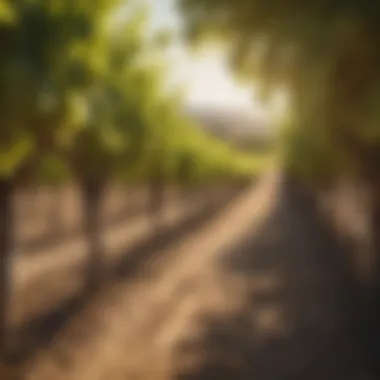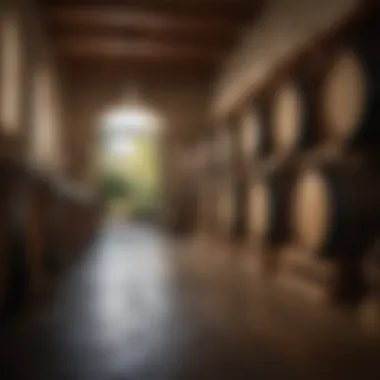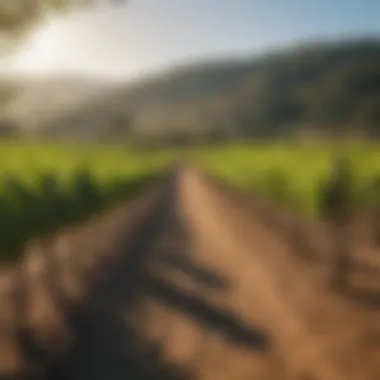Uncovering the Hidden Gems of Small Napa Wineries


Intro
In the exclusivity of Napa Valley lies a rich tapestry of small wineries, where every bottle tells a story. These intimate producers often create exceptional wines through artisanal techniques and innovative practices, setting them apart from their larger counterparts. A popular wine region, Napa not only showcases exceptional vineyard landscapes but encapsulates the essence of sustainability. By exploring these wines, enthusiasts can connect directly with the land.
Many wine lovers turn to small wineries for their unique offerings. Unlike mass-production brands, these establishments can prioritize quality over quantity, nurturing each grape with care. The result is a distinct flavor profile, often interlaced with personal narratives that resonate with oenephiles. This article elucidates several noteworthy aspects that make these hidden gems invaluable components of the Napa wine experience, shedding light on both their cultural significance and individual characteristics.
Intro to Napa Valley
Understanding Napa Valley is essential to appreciating the depth and complexity of its wineries. Renowned worldwide for its exquisite wines, Napa serves as a microcosm of the viticultural experience. A focus on small wineries illustrates a narrative entwined within the fabric of this region, offering insights into both winemaking and local Sanlulture.
Historical Overview
The history of Napa Valley stretches back to the ancestral Native American communities who first settled the region. With the 19th century gold rush, the area began to attract a diverse population. The introduction of viticulture came with European emigrants who recognized the land's potential. By the late 1800s, Napa became highly regarded for its wine production. Prohibition had drastic effects, but the 20th century revival paved the way for Napa's emergence as a global wine capital. Each phase of this evolution holds a key to understanding today's small wineries, their methods, and their passionate commitment to the craft.
Geographical Significance
Napa Valley is characterized by its unique geographical features, contributing to suitable wine-growing conditions. The valley benefits from a diversity of climate types, ranging from Mediterranean to cooler microclimates. The specific topography, including mountain ranges and volcanic soils, adds complexity to the local terroir. \n Rainfall patterns and temperature variations create pockets ideal for various grape varietals. For example, Cabernet Sauvignon thrives along the warmer southern end, while cooler areas nurture Chardonnay and Pinot Noir.
Napa's geography is critical to sustaining its diverse, small scale producers.
This distinct geography not only breeds high-quality grapes but also defines the small wineries' place within the global wine industry.
Defining Small Wineries
Small wineries hold a significant place in the Napa Valley and the broader wine industry. Recognizing and understanding defining small wineries provides a foundation for appreciating their unique offerings. Unlike larger establishments that emphasize mass production, small wineries focus on quality and craftsmanship. The wine experience here is often paired with personalization that larger operations cannot match. For a high-end audience, these nuances play a critical role in choosing a vineyard to visit or purchase from.
Criteria for Classification
Several key features distinguish small wineries from larger competitors. The classification typically hinges on:
- Production Size: A winery's annual grape processing volume often determines its status as small. Many small wineries operate with lower output, often under an annual threshold of 10,000 cases.
- Ownership Structure: Small wineries are frequently family-owned or operated, fostering a distinct tradition and character. This disconnected from corporation teaches individual attention to vineyard management and visitor interactions.
- Vineyard Sourcing: Many small producers grow their grapes. This makes them unique as they have control over vineyard practices, allowing for a richer and more meaningful product.
Understanding these criteria is essential. They illuminate why and how these wineries develop a profound connection to their land and customers.
Distinctive Characteristics
Small wineries possess several distinguishing traits that further enhance their allure:
- Artisanal Methods: Smaller scale processes often allow for artisanal winemaking techniques. Vineyards might adhere to organic or biodynamic practices, emphasizing grape and wine quality.
- Personalized Experiences: Visitors often benefit from personalized tours and tastings. Winemakers themselves might guide enthusiasts through their selections, sharing stories and insights directly linked to the wines.
- Innovative Approaches: Small wineries frequently have the freedom to experiment. This creative liberty can lead to unique flavor profiles and unusual blends, making their offerings stand out in a crowded market.
Advantages of Small Wineries
Small wineries, often overshadowed by larger brands, hold advantages that cater to discerning wine enthusiasts. These benefits manifest in various ways, ultimately offering a deeply enriching experience for consumers. The focus on quality production, personalized service, and innovation sets small wineries apart.
Quality of Production
Small wineries prioritize quality above quantity. When production is limited, producers can devote greater attention to each bottle, ensuring that every grape is handled with care.
Variability in conditions, such as soil and climate, often contrasts between small and large operations. Small wineries utilize these nuances to develop distinct character in their wines. Many employ traditional and organic methods, often eschewing synthetic interventions.


Let’s explore some key points on quality production from small wineries:
- Hands-on Techniques: Owners and winemakers often participate directly in every stage.
- Smaller Batches: Limited production allows for meticulous attention.
- Flavor Profiles: Emphasis on unique terroirs helps create a signature taste.
This hands-on approach often results in wines that reflect their environment and create memorable tasting experiences.
Personalized Wine Experiences
Engaging with small wineries usually means more than just a wine tasting. Visitors can enjoy intimate encounters with passionate producers. Personal interactions lead to enhanced learning.
These sessions can be quite enlightening. The focus tends to be on sharing insight about:
- Wine Making Processes: Gain knowledge on the intricacies behind each varietal.
- Tasting Notes: Explore why winemakers choose certain characteristics.
- Stories: Understand local culture and norms that shape wine production.
Undoubtedly, this personalized attention can transform a simple tasting into an educational experience, forging connections between the consumer and the producer.
Creative Freedom and Innovation
Small wineries flourish on innovative approaches that larger counterparts may not embrace. Being less bound by corporate stricture allows for artisanal experimentation.
Small winemakers often invent blends or techniques that enhance the identity of their beverages. Some adopted practices include:
- Unique Blending: Crafting proprietary mixes that combine uncommon varietals.
- Sustainable Practices: Going organic or biodynamic opens doors for fresh techniques.
- Limited Editions: Often, they launch exclusive releases capturing specific moments, truly defining creativity.
This aspect of creativity not only caters to evolving tastes among consumers but encourages a vibrant local winemaking culture.
Small wineries represent an ecosystem where passion fuels ingenuity, paving the way for innovative wine experiences for every discerning palate.
As the consumer market becomes progressively selective in choosing high-quality offerings, these winery features do much to enhance their appeal in rich flavors.
Key Small Wineries in Napa
The focus on small wineries within Napa is crucial to understanding the unique niche they fulfill. These wineries not only embody the essence of Napa Valley but also contribute significantly to the wine culture and economy. Unlike large production wineries, small operations prioritize quality over quantity. This makes visiting them a rare opportunity to experience artisanry first-hand.
Through small wineries, discerning wine enthusiasts can dive deeper into wine's complexities. Each small winery tells a story — from terroir to technique. As we explore selected wineries, artisan methods, and their economic impact, one can appreciate how these hidden gems enrich Napa's viticulture.
Presentation of Selected Wineries
In Napa Valley, several small wineries are noteworthy due to their commitment to excellence and innovation. Each selected winery differs not just in wines but also in stories and cultures.
- Benessere Vineyards: Focusing on Italian varietals, Benessere's picturesque setting inspires visitors. Visitors often find themselves exploring more than just the wines, as the scenic beauty plays a significant part in the experience.
- Pine Ridge Vineyards: Known for its unique blending techniques, it offers wine tasting experiences breathtaking views. The mastery in blending illustrates the winery’s expertise.
- Domaine Carneros: Rooted in champagne tradition, Domaine Carneros embodies a fusion of elegance and craftsmanship. Their sparkling wines capture the spirits of celebration in an unforgettable setting.
Visiting these wineries provides an opportunity to understand their offerings’ nuances better. They fully define what a small winery represents in Napa - individuality, creativity, and strong community ties.
Focus on Artisan Techniques
Small wineries are marked by the artisan techniques they employ. Such methods embody a more hands-on approach, often resulting in unique products that differ marked from mass-produced wines. Several distinctive techniques set small producers apart:
- Hand Harvesting: Grapes are often hand-picked at small wineries. This method allows for a careful selection, ensuring only the finest grapes are used in their wine production.
- Natural Fermentation: Many small producers opt for wild yeast fermentation. It amplifies terroir-driven character, adding depth to the final products.
- Creative Aging Solutions: Customized barrel aging, along with varying barrel sizes, allows for distinctive flavor profiles that stand out.


The focus on traditional and innovative practices creates a distinct identity for the wine produced. As mentioned in one consumer review, “You really feel the vineyard’s personality in every pour.”
Contribution to Local Economy
Small wineries play a pivotal role in Napa's local economy. Their contributions span beyond just crafting wines. They create jobs, spur tourism, and support community events.
- Job Creation: Small vineyards create various job opportunities; from harvesters to seasonal workers and even permanent staff tied to production.
- Tourism Boost: Visitors often flock to Napa specifically to discover these small, intimate wineries. This increases foot traffic and benefits nearby businesses.
- Community Events: Committing to local partnerships, many small wineries host tastings and events showcasing not just their wines, but also local fare, fostering a vibrant community.
Ultimately, small wineries foster a sense of togetherness among wine lovers while ensuring that Napa sustainably thrives—a testament to their enduring relevance in the large landscape of the region.
Exploring Wine Varietals
The exploration of wine varietals is integral to understanding the appeal of small Napa wineries. Such establishments often specialize in unique grape types, allowing for distinctive flavors and aromas that larger wineries may not prioritize. Emphasizing unique varietals provides an opportunity to appreciate the significant diversity within Napa Valley's wine production, catering to an audience that seeks not just flavor, but a story behind each bottle.
Unique Grapes and Their Profiles
Small Napa wineries frequently showcase grape varietals that are less commonly found in larger commercial operations. For instance, Petite Sirah, known for its deep color and robust tannins, charms a particular segment of wine lovers. In contrast, Grenache offers bright red fruit characters, lending a softer alternative for those who prefer lighter profiles.
These unique grapes come with distinct profiles:
- Characteristics: Varieties such as Tannat showcase high tannin levels while offering bold flavors of leather and spice.
- Terroir Reflection: Small wineries explore plots that highlight the soil and climate, presenting vivid narratives about their unique terroirs through their wines.
Moreover, growers engage in practices centered around these varietals, consciously choosing their planting styles
- for improved resilience.
- This emphasis on local propagation sometimes means working in aligned harmony with new climate conditions. Overall, each unique grape contributes to an ever-evolving landscape of wine production—one that celebrates innovation as much as tradition.
Innovative Blending Techniques
Innovative blending techniques also set small wineries apart from larger producers in Napa Valley. Mastering the art of blending not only enhances flavors but allows oenologists to achieve exceptional complexity.
Many small producers often trial new combinations without the fear that larger brands encounter due to established reputations. This freedom permits some fascinating explorations such as:
- Merlot and Syrah Blends: Often achieve rich depth, providing elegance and structure without overwhelming the palate.
- Cabernet Franc with Sauvignon: Offering lively acidity complemented by earthy undertones, resulting in a dynamic drinking experience.
Small wineries mabrace new techniques that tackle challenges inherent within wine production, let the dialogue among oenologists lead them further. They might experiment with barrel types or soil blends for growing conditions, inviting consumers into a world of sophisticated choices that larger wineries often miss.
Understanding these varietals along with cutting-edge blending methodologies enriches the wine enthusiast’s prospect when selecting who to follow in Napa Valley. Their discerning nature shows it’s not just the product but the layered04002556, contemplative journey taken to create unique wines found in the charming small wineries scattered throughout.*
Sustainability Practices
Sustainability has emerged as a crucial aspect of modern wine production, particularly among small wineries in Napa. These wineries often prioritize environmental stewardship through practices that promote ecological well-being alongside their craft. Sustainability in winemaking not only addresses the ecological challenges of the contemporary world but also resonates with the values of many consumers. As such, this section will look at the dual facets of sustainability: environmental responsibility and community engagement.
Environmental Responsibility
A small winery's commitment to environmental responsibility manifests in various practices aimed at reducing their carbon footprint and conserving natural resources. These wineries frequently adopt organic farming methods, avoiding harmful pesticides and chemicals, which helps maintain soil vitality and protect local biodiversity.
Many small Napa wineries are increasingly employing regenerative agriculture approaches. This means beyond merely sustainable farming, they work towards improving ecosystem health. Such methods can include cover cropping, which enriches soil and suppresses weeds, and biodiversity planting schemes that restore natural habitats. Winemakers like Frog’s Leap Winery emphasize sustainability by utilizing drip irrigation to conserve precious water resources.
The adoption of solar energy sources and other renewable resources is another aspect. By installing solar panels, these wineries minimize reliance on fossil fuels, cutting down emissions significantly.


The transition to sustainable practices often leads to improved wine quality, as vineyards providing a healthful environment for grapes foster richer flavors.
Community Engagement
Beyond their ecological initiatives, small Napa wineries play a vital role in fostering community connections and local economies. They often engage with local farmers and artisans, forming partnerships that create a network of support that keeps resources circulating within the community. Consumer education is key here. Many small wineries host events and tastings, where they inform visitors about sustainable practices, such as the importance of biodiversity.
Additionally, these small producers frequently contribute to local initiatives focused on environmental conservation. They support community gardens and participate in programs that promote biodiversity beyond their vineyard boundaries. For instance, Turnbull Wine Cellars takes part in local conservation efforts, demonstrating an integral cooperative relationship with their surroundings.
Visiting Small Wineries: Practical Insights
Visiting small wineries in Napa Valley offers not just wine tasting but a journey into the heart of winemaking culture.\nSmall wineries are often led by passionate owners and winemakers, and they have their personal touch that larger facilities generally don't provide. These visits allow for a more intimate experience, enhancing the connection between the wine and the consumer. In this section, we will discuss how to plan a trip to these distinctive wineries and what visitors can expect during their experiences.
Planning Your Trip
Planning a visit to small wineries is crucial for maximizing your experience. Consider these important factors:
- Timing Your Visit: Many wineries are open for tastings on weekends but also on specific weekdays. It is wise to check each winery's schedule in advance to avoid disappointments.
- Reservations: Given their size, many small wineries operate on an appointment-only basis, which helps manage visitor flow. Making a reservation can help ensure a personalized experience,
- Transportation: Arranging transportation is essential. Whether you choose a designated driver, local taxis, or chauffeured services, planning ahead ensures safety and enjoyment.
- Combining Visits: Use a map or a list of nearby wineries to plan a cohesive day. Concentrating on a specific area in Napa Valley can reduce travel time between visits.
These strategies aid in curating an enriching experience, not only tasting wines but also engaging with those who create them.
What to Expect
Visiting small wineries presents unique experiential opportunities. Here are some expectations you may have:
- Educational Tastings: Be prepared for in-depth discussions about each wine. Many owners or winemakers enthusiastically share their knowledge regarding varietals, terroir, and winemaking philosophy. Expect to gain a deeper understanding of not just the wine, but also the processes that lead to its creation.
- Personalized Experience: Unlike larger operations that follow a scripted approach, small wineries provide tailored experiences based on visitors’ preferences. You might receive special wine pairings with local cheeses or guided tours of the vineyards.
- Seeing Artisan Processes: Many small wineries nourish innovative techniques. As you tour their facilities, observe these practices firsthand. Witnessing barrel aging processes or grape sorting can be enlightening and offers a thoughtful context for the wine being tasted.
”At small wineries, it’s not just about the wine; it’s about the whole journey behind each bottle.”
- Meeting the People Behind the Bottle: Engaging with the individuals who craft your wine is a transcendent experience. They often have stories intertwined, showcasing their challenges and triumphs, which adds layers to the quality of their wines.
Delving into these practical insights will enrich one’s understanding of Napa Valley's small wineries, bridging the world between viticulture and personal connection.
Culmination: The Allure of Small Wineries
The exploration of small wineries in Napa Valley reveals a fascinating interplay of tradition and innovation. Small wineries distinguish themselves by focusing on high-quality production and intimate experiences, appealing to a niche of discerning wine enthusiasts. This evaluation underscores their significance in the broader landscape of Napa's wine industry, as they represent both custodians of rich history and pioneers of contemporary practices.
Recap of Small Winery Benefits
Small wineries offer several notable benefits:
- Quality of Wines: These establishments prioritize exceptional flavor and quality over large volumes. The meticulous care given to cultivation and harvesting often results in superior vintages.
- Personal Touch: Engaging directly with winemakers can provide an enriched understanding of each wine’s story. Visitors generally have more opportunities for conversations during tastings.
- Experiential Value: Each visit is unique, often combining stunning settings with personalized tours that detail the winemaking process.
- Sustainability Practices: Conscientious methods in grape growing and production can lead to better environmental outcomes, allowing visitors to support eco-friendly practices.
In this context, small wineries not only produce excellent wines but also cultivate memorable wine experiences that resonate well beyond the initial sip.
The Future of Small Production
Looking ahead, the future for small wineries appears promising. Trends indicate a growing consumer interest in lesser-known varietals and artisanal production methods. This shift is fundamental for nurturing a diverse wine community.
Factors likely influencing small winery growth are:
- Digital Presence: Enhanced online strategies, such as social networks and dedicated websites, are facilitating better customer reach and engagement.
- Sustainability Commitment: As environmental awareness rises, small wineries that prioritize sustainable methods are likely to attract a responsible clientele.
- Culinary Partnerships: Collaborations with local chefs and dining establishments can enhance wine visibility and appreciation.
"Small wineries are at the forefront of a cultural shift towards quality and responsibility in wine production."
The trajectory toward greater consumer engagement and a focus on sustainability suggests a bright future for small Napa wineries. Ultimately, while they overcome challenges, their commitment to excellence and uniqueness sets a benchmark in the wine industry.







